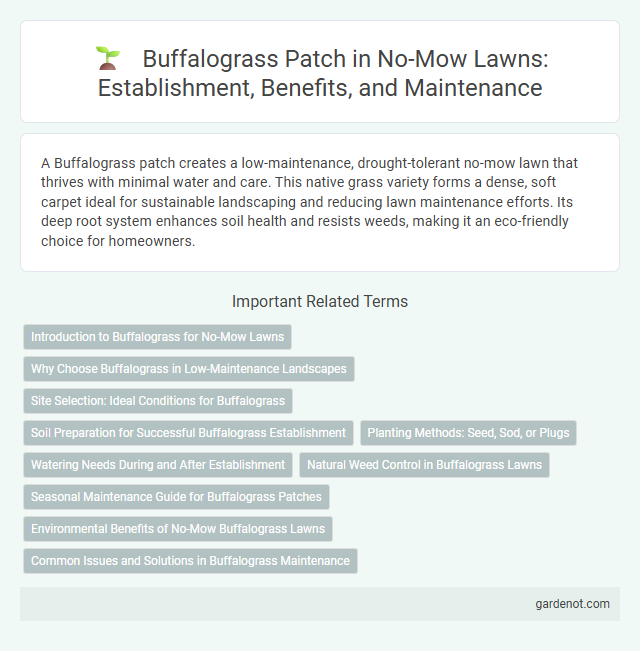A Buffalograss patch creates a low-maintenance, drought-tolerant no-mow lawn that thrives with minimal water and care. This native grass variety forms a dense, soft carpet ideal for sustainable landscaping and reducing lawn maintenance efforts. Its deep root system enhances soil health and resists weeds, making it an eco-friendly choice for homeowners.
Introduction to Buffalograss for No-Mow Lawns
Buffalograss is a drought-tolerant, native North American grass ideal for no-mow lawns due to its low growth rate and minimal maintenance requirements. This warm-season grass thrives in full sun and adapts well to various soil types, reducing the need for frequent watering and mowing. Its dense, fine-textured foliage naturally suppresses weeds, creating a resilient and sustainable lawn option.
Why Choose Buffalograss in Low-Maintenance Landscapes
Buffalograss thrives in low-maintenance landscapes due to its exceptional drought tolerance and minimal mowing requirements, making it an ideal choice for eco-friendly lawns. Its deep root system conserves soil moisture and reduces irrigation needs, significantly lowering water consumption. Buffalograss also resists common pests and diseases, minimizing the need for chemical treatments and upkeep.
Site Selection: Ideal Conditions for Buffalograss
Buffalograss thrives best in well-drained soils with a sandy or loamy texture, preferring full sun exposure to maximize growth and color intensity. Ideal soil pH ranges from 6.0 to 7.5, ensuring nutrient availability and healthy root development. Selecting a site with minimal shade and good air circulation supports buffalograss's drought tolerance and low-maintenance requirements.
Soil Preparation for Successful Buffalograss Establishment
Preparing soil for successful buffalograss establishment involves thoroughly tilling the area to a depth of 4-6 inches to ensure proper aeration and root penetration. Removing weeds and debris before planting minimizes competition and promotes healthy growth, while testing soil pH to maintain it between 6.0 and 7.5 optimizes nutrient availability. Incorporating organic matter or balanced fertilizers enhances soil fertility, creating an ideal environment for buffalograss to thrive in no-mow lawn settings.
Planting Methods: Seed, Sod, or Plugs
Buffalograss can be established through seed, sod, or plugs, each method offering distinct advantages for no-mow lawns. Seeding is cost-effective and suitable for large areas but requires patience and proper soil preparation to ensure germination. Sod provides an instant, uniform lawn with immediate weed control, while plugs offer a slower, more affordable option that gradually fills in bare spots with minimal maintenance.
Watering Needs During and After Establishment
Buffalograss requires consistent watering of about 1 to 1.5 inches per week during establishment to promote deep root growth and resilience. After the initial growing period of 6 to 8 weeks, reduce watering frequency to once every 10 to 14 days, allowing the soil to dry slightly between sessions. Proper watering management minimizes disease risk and ensures a drought-tolerant, low-maintenance no-mow lawn.
Natural Weed Control in Buffalograss Lawns
Buffalograss lawns naturally suppress weeds due to their dense growth habit and deep root system, which outcompete many common lawn weeds. The minimal mowing requirement helps maintain a healthy turf that prevents weed seeds from establishing. This makes Buffalograss a sustainable choice for natural weed control in eco-friendly landscaping.
Seasonal Maintenance Guide for Buffalograss Patches
Buffalograss patches require minimal seasonal maintenance, thriving with low water and nutrient demands, making them ideal for no-mow lawns. During early spring, apply a balanced fertilizer high in nitrogen to encourage healthy growth, followed by light irrigation to prevent drought stress. In late fall, reduce watering and avoid heavy foot traffic to prepare the patch for dormancy and ensure vigorous regrowth in the next season.
Environmental Benefits of No-Mow Buffalograss Lawns
No-mow Buffalograss lawns significantly reduce water consumption by requiring minimal irrigation compared to traditional turfgrass, making them ideal for drought-prone regions. Their deep root systems enhance soil health and prevent erosion, while supporting local biodiversity by providing habitat for beneficial insects and pollinators. By eliminating the need for regular mowing, Buffalograss patches also lower carbon emissions and reduce fuel consumption from lawn equipment, contributing to cleaner air and a smaller environmental footprint.
Common Issues and Solutions in Buffalograss Maintenance
Buffalograss patches commonly face issues such as patchy growth, weed invasion, and drought stress due to their shallow root systems. Regular aeration and overseeding help address thinning areas, while applying pre-emergent herbicides in early spring effectively controls common grassy and broadleaf weeds. Proper irrigation practices, including deep but infrequent watering, enhance drought resistance and promote healthy, dense buffalograss coverage.
Buffalograss patch Infographic

 gardenot.com
gardenot.com